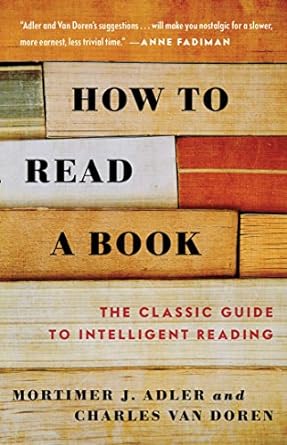How to Read a Book at Amazon.com
“How to Read a Book: The Classic Guide to Intelligent Reading” by Mortimer J. Adler and Charles Van Doren is a timeless manual on reading comprehension and analytical reading skills. Originally published in 1940 and later revised in 1972, the book offers a systematic approach to reading different types of literature, from practical books to imaginative works. Adler and Van Doren introduce various levels of reading—elementary, inspectional, analytical, and syntopical—and provide techniques for improving understanding and retention. The book also covers how to critically engage with texts, ask the right questions, and synthesize information from multiple sources. “How to Read a Book” is an essential guide for students, educators, and anyone looking to enhance their reading abilities and derive more value from their reading experiences.
Similar Books
“The Well-Educated Mind: A Guide to the Classical Education You Never Had” by Susan Wise Bauer
Bauer offers a comprehensive guide to reading and understanding classic literature, covering fiction, autobiography, history, drama, and poetry.
“How to Read Literature Like a Professor: A Lively and Entertaining Guide to Reading Between the Lines” by Thomas C. Foster
Foster provides insights into the deeper meanings and themes in literature, helping readers appreciate and analyze texts more effectively.
“Reading Like a Writer: A Guide for People Who Love Books and for Those Who Want to Write Them” by Francine Prose
Prose offers practical advice on how to read with a writer’s eye, analyzing the techniques used by great authors.
“The Art of Reading” by Damon Young
Young explores the philosophical and practical aspects of reading, emphasizing its transformative power and the joy it brings.
“Amusing Ourselves to Death: Public Discourse in the Age of Show Business” by Neil Postman
Postman examines the impact of television and media on public discourse and critical thinking, emphasizing the importance of reading and intellectual engagement.
“Mortimer Adler: An Introduction to His Works” by Milton Mayer
Mayer provides an overview of Adler’s contributions to philosophy, education, and the study of great books, offering insights into his approach to reading and learning.
“The Intellectual Life: Its Spirit, Conditions, Methods” by A.G. Sertillanges
Sertillanges offers a guide to living an intellectual life, covering topics such as reading, thinking, and writing with purpose and depth.
“The Elements of Style” by William Strunk Jr. and E.B. White
This classic guide to writing provides practical advice on clear and effective communication, which is essential for understanding and producing high-quality texts.
“A History of Reading” by Alberto Manguel
Manguel explores the history and significance of reading in various cultures and time periods, offering a rich perspective on the practice of reading.
“Why Read the Classics?” by Italo Calvino
Calvino discusses the importance of reading classic literature and provides insights into why these works continue to be relevant and meaningful.
“The Pleasures of Reading in an Age of Distraction” by Alan Jacobs
Jacobs offers advice on how to cultivate a love of reading and maintain focus in a world filled with distractions.
“The Little Guide to Your Well-Read Life” by Steve Leveen
Leveen provides practical tips for developing a fulfilling reading life, including how to choose books and make time for reading.
“Slow Reading in a Hurried Age” by David Mikics
Mikics advocates for the practice of slow reading to enhance comprehension and enjoyment of literature.
“On Writing Well: The Classic Guide to Writing Nonfiction” by William Zinsser
Zinsser’s guide to writing nonfiction emphasizes clarity, simplicity, and the importance of reading widely to improve writing skills.
“Critical Reading and Writing for Postgraduates” by Mike Wallace and Alison Wray
Wallace and Wray offer strategies for developing critical reading and writing skills, particularly in the context of academic research.
“The Art of Thinking Clearly” by Rolf Dobelli
Dobelli explores common cognitive biases and logical errors, providing insights that can improve critical thinking and reading comprehension.
“The Uses of Literacy” by Richard Hoggart
Hoggart examines the role of literature and reading in shaping culture and society, emphasizing its importance for personal and collective development.
“The Great Books: A Journey Through 2,500 Years of the West’s Classic Literature” by Anthony O’Hear
O’Hear provides an overview of the Western literary canon, discussing the significance of major works and their contributions to intellectual history.
“The Art of Biblical Narrative” by Robert Alter
Alter offers insights into the literary techniques used in the Bible, helping readers appreciate its narrative artistry and thematic depth.
“The Educated Imagination” by Northrop Frye
Frye explores the relationship between literature and the human imagination, offering a compelling case for the value of reading.
